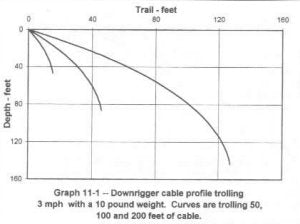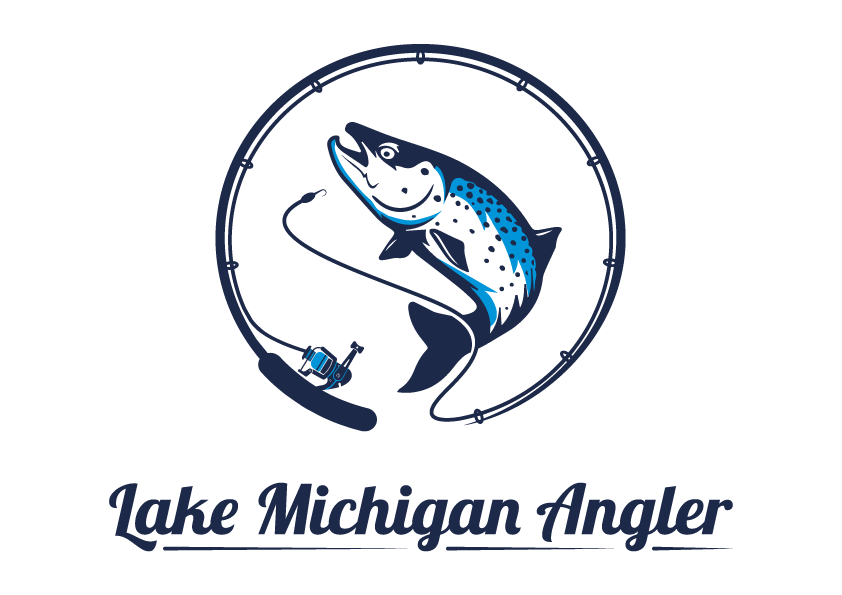There are several methods that have been used for determining the actual depth of the downrigger ball when trolling. The most important thing to remember is that the counters on the downriggers are measuring the amount of wire cable out, not the actual depth. The actual depth is affected by the speed the boat is traveling, the amount of underwater current and its direction, the size of the downrigger weights, the shape of the downrigger weights, and finally by the drag produced by the lure, downrigger ball, and cable.

Method 1
Method for estimating the depth of downrigger ball is based on measuring length cable angle measurement and measured in degrees from vertical. estimates can be calculated distance back a vertical position that would located. several angles desired depths are provided chart below:| Cable Length and distance back from desired Depth and estimated angle |
||||||||
|---|---|---|---|---|---|---|---|---|
| 20 degrees | 30 degrees | 40 degrees | 45 degrees | |||||
| Desired Depth in feet | Cable Length | Back | Cable Length | Back | Cable Length | Back | Cable Length | Back |
| 10 | 11 | 4 | 12 | 6 | 13 | 8 | 14 | 10 |
| 20 | 21 | 7 | 23 | 12 | 26 | 17 | 28 | 20 |
| 30 | 32 | 11 | 35 | 17 | 39 | 25 | 42 | 30 |
| 40 | 43 | 15 | 46 | 23 | 52 | 34 | 57 | 40 |
| 50 | 53 | 16 | 58 | 29 | 65 | 42 | 71 | 50 |
| 60 | 64 | 22 | 69 | 35 | 78 | 50 | 85 | 60 |
| 70 | 74 | 25 | 81 | 40 | 91 | 59 | 99 | 70 |
| 80 | 85 | 29 | 92 | 46 | 104 | 67 | 113 | 80 |
| 90 | 96 | 33 | 104 | 52 | 117 | 76 | 127 | 90 |
| 100 | 106 | 36 | 115 | 58 | 131 | 84 | 141 | 100 |
| 125 | 133 | 45 | 144 | 72 | 163 | 105 | 177 | 125 |
| 150 | 160 | 55 | 173 | 87 | 198 | 128 | 212 | 150 |
| 175 | 186 | 64 | 202 | 101 | 228 | 147 | 247 | 175 |
| 200 | 216 | 73 | 231 | 115 | 261 | 168 | 283 | 200 |
| 225 | 239 | 82 | 260 | 130 | 294 | 189 | 318 | 225 |
| 250 | 266 | 91 | 289 | 144 | 326 | 210 | 354 | 250 |
Method 2
This method determines the proper downrigger weight size based on trolling speed and the depth required. The amount of weight required is a function of the speed you are trolling and the depth you are fishing. The deeper and faster you go, the more weight you need to keep the downrigger wire at a near vertical angle. Charts for different speeds and size weights are located at the Scotty Downrigger web site.

Method 3
This method determines the depth of the downrigger ball Troller's Handbook by Ray Rychnovskyand the distance from vertical that the downriggger ball is located. This method is described in a book "The Troller's Handbook" by Ray Rychnovsky, published by Frank Amato Publications. Calculations using differential equations and difference equations are used to calculate for hydrodynamic forces that act on the downrigger ball, downrigger cable, lure,Troller's Handbook by Ray Rychnovsky and fishing line. A series of charts are provided in the book that provide depth estimates for different size weights at different trolling speeds. Other sections of the book estimate the trolling depths at different speeds for different diameter fishing lines, leadcore line, and wire line.

Method 4
This method uses actual measurements taken with your Fish Finder or GTM 40own boat and downriggers. The Fish Finder or GTM 40 is a device that measures water temperature and depth. When attached to the downrigger ball the unit will record water temperature at 5 foot depth intervals. The unit stops recording depth and temperature after staying at the same depth for 15 seconds. When the unit is retrieved you press a switch on the unit that will cause the unit to playback the depth and temperature in 5 foot increments. All you need to do is reach your favorite trolling speed, attach the unit to a downrigger ball, lower 50 feet of cable, then wait 15 seconds. Raise the downrigger and display the actual depth of the downrigger ball.The GMT 40 has been discontinued by the manufacture and is no longer available


























